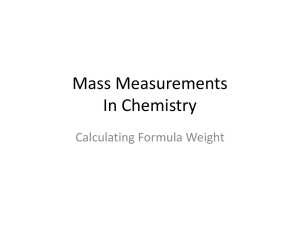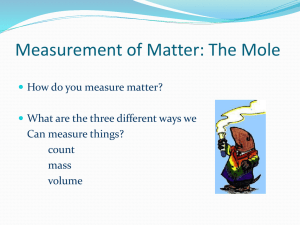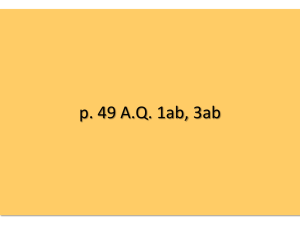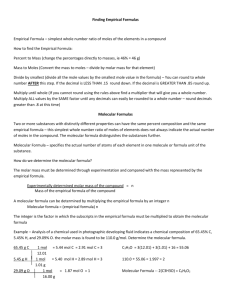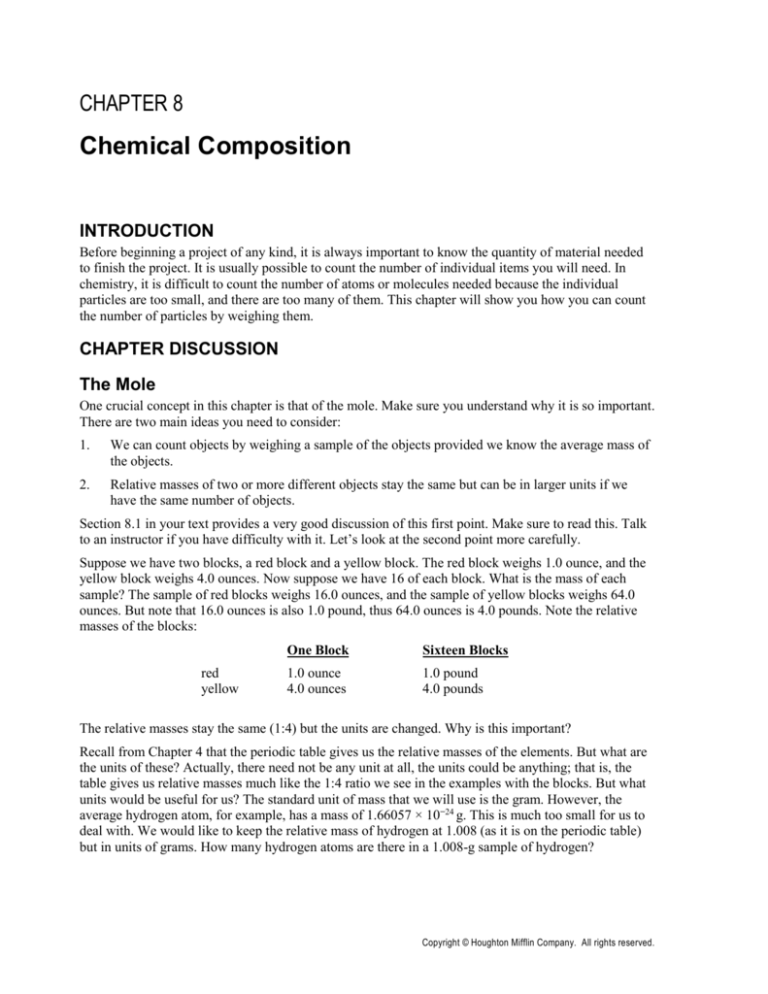
CHAPTER 8
Chemical Composition
INTRODUCTION
Before beginning a project of any kind, it is always important to know the quantity of material needed
to finish the project. It is usually possible to count the number of individual items you will need. In
chemistry, it is difficult to count the number of atoms or molecules needed because the individual
particles are too small, and there are too many of them. This chapter will show you how you can count
the number of particles by weighing them.
CHAPTER DISCUSSION
The Mole
One crucial concept in this chapter is that of the mole. Make sure you understand why it is so important.
There are two main ideas you need to consider:
1.
We can count objects by weighing a sample of the objects provided we know the average mass of
the objects.
2.
Relative masses of two or more different objects stay the same but can be in larger units if we
have the same number of objects.
Section 8.1 in your text provides a very good discussion of this first point. Make sure to read this. Talk
to an instructor if you have difficulty with it. Let’s look at the second point more carefully.
Suppose we have two blocks, a red block and a yellow block. The red block weighs 1.0 ounce, and the
yellow block weighs 4.0 ounces. Now suppose we have 16 of each block. What is the mass of each
sample? The sample of red blocks weighs 16.0 ounces, and the sample of yellow blocks weighs 64.0
ounces. But note that 16.0 ounces is also 1.0 pound, thus 64.0 ounces is 4.0 pounds. Note the relative
masses of the blocks:
red
yellow
One Block
Sixteen Blocks
1.0 ounce
4.0 ounces
1.0 pound
4.0 pounds
The relative masses stay the same (1:4) but the units are changed. Why is this important?
Recall from Chapter 4 that the periodic table gives us the relative masses of the elements. But what are
the units of these? Actually, there need not be any unit at all, the units could be anything; that is, the
table gives us relative masses much like the 1:4 ratio we see in the examples with the blocks. But what
units would be useful for us? The standard unit of mass that we will use is the gram. However, the
average hydrogen atom, for example, has a mass of 1.66057 × 10−24 g. This is much too small for us to
deal with. We would like to keep the relative mass of hydrogen at 1.008 (as it is on the periodic table)
but in units of grams. How many hydrogen atoms are there in a 1.008-g sample of hydrogen?
Copyright © Houghton Mifflin Company. All rights reserved.
Chapter 8: Chemical Composition
71
1 atom H
23
1.008 g H ×
= 6.022 × 10 H atoms
24
1.66057 10 g H
Thus, if we have 6.022 × 1023 atoms of hydrogen the sample will have a mass of 1.008 g. Along the
same lines, if we have 6.022 × 1023 atoms of carbon, the sample will have a mass of 12.01 g. If we have
6.022 × 1023 atoms of oxygen, the sample will have a mass of 16.00 g. That is, 6.022 × 1023, which is
called a mole, is the number that converts the units on the periodic table (called amu or atomic mass
units) to grams.
The mole is just a number (like a dozen is 12), and it allows us to convert between how many atoms (or
molecules) we have and the mass of the sample. In the example with the blocks, this number was 16 (to
convert ounces to grams). To convert amu to grams, we use the mole.
Formulas and Mass Percent
Would you say ammonia (NH3) is mostly nitrogen or mostly hydrogen? Your answer depends on if you
are looking at the number of atoms or the mass of the atoms. In terms of numbers of atoms, ammonia is
¾ hydrogen (there are four atoms making up an ammonia molecule, and three of them are hydrogen).
But it is often important to know the composition by mass of a compound. Chemists have instruments
that give them percent by mass data, and they use this to determine the formulas of compounds. How
can we do this?
Suppose we have 1.0 mole of ammonia molecules. The molar mass is 17.034 g (N = 14.01 g/mol, and
each hydrogen is 1.008 g/mol, so the molar mass of NH3 is 14.01 + 3(1.008) = 17.034 g). How much of
this mass is hydrogen? How much of this mass is nitrogen?
Since there are three hydrogen atoms per ammonia molecule, there are three moles of hydrogen atoms
per mole of ammonia molecule. Thus, the total mass of hydrogen should be 3(1.008) or 3.024 g, and
there is 14.01 g of nitrogen. The mass percent of each element is:
Hydrogen:
3.024 g
100% = 17.75% hydrogen by mass
17.034 g
Nitrogen:
14.01 g
100% = 82.25% nitrogen by mass
17.034 g
Note that even though there are more hydrogen atoms than nitrogen atoms, the percent by mass of
hydrogen in this case is lower than that of nitrogen.
Try the following example before reading on:
What is the mass percent of hydrogen and of nitrogen for the compound N2H6?
To solve this, you can find the molar mass of the compound, which is 34.068, and the total mass of
hydrogen (6.048 g) and nitrogen (28.02 g). If you are having difficulty getting these numbers, read
through your text or talk with your instructor.
Thus, the mass percent of each element is:
Hydrogen:
6.028 g
100% = 17.75% hydrogen by mass
34.068 g
Nitrogen:
28.02 g
100% = 82.25% nitrogen by mass
34.068 g
Copyright © Houghton Mifflin Company. All rights reserved.
72
Chapter 8: Chemical Composition
Why is this significant? Note that this is the same percent by mass as ammonia (NH3). Chemists
generally use percent-by-mass data to determine the formula of a compound. But what if we know a
compound is 17.75% hydrogen by mass and 82.25% nitrogen by mass? Is the formula NH3? Or N2H6?
Actually, you should prove to yourself that any formula that has 3 times as many hydrogen atoms as
nitrogen atoms (NxH3x) will be 17.75% hydrogen and 82.25% nitrogen by mass. So what are we to do?
This is why we need to know the molar mass of a compound to know the actual formula for the
compound (the molecular formula). Given just the percent-by-mass data allows us to determine only the
ratio of atoms in the molecule (in this case 1:3) and determine the empirical formula. Let’s consider an
example.
A compound consisting of carbon, hydrogen, and oxygen is 40.00% carbon by mass and 6.71%
hydrogen by mass. What is the empirical formula of the compound?
In this case, we are given the percent-by-mass data and are asked to determine the formula for the
compound. How should we think about this?
We are looking for the formula (empirical) of this compound. Recall that the formula gives us the ratio
of atoms in the compound. The general formula for this compound is
CxHyOz
where x, y, and z represent the number of atoms in one molecule of the compound (or, in the case of the
empirical formula, the lowest whole-number ratio). Our problem, then, is to determine these numbers.
Thus, we have been given mass-percent data for the atoms and need to determine the number of atoms.
In essence, we will have to change a mass to a number. How do we do this? Well, we know, for
example, that 1 mole (a number, 6.022 × 1023) of carbon atoms has a mass of 12.01 g. Thus, we will use
the molar mass of the atoms to make this conversion.
Before we go on, notice that we have done quite a bit of thinking about this problem before doing any
calculations. This is generally a good approach with chemistry problems. That is, think about the setup
of the problem before worrying about the specifics. Do not immediately try to plug numbers into a
given equation. Think about the problem first.
Now we know that we will need to convert the mass data to numbers using the mole. But what is the
mass of carbon? Hydrogen? Oxygen? We are only given the mass-percent data. This requires us to
think about what is meant by mass percent.
Stating that the compound is 40.00% carbon by mass means that for every 100.00 g of compound,
40.00 g is carbon.
It is not stating that we have 40.00 g of carbon necessarily, but that 40.00 g out of every 100.00 g of
compound is carbon (if we had 200.00 g of compound, we would have 80.00 g of carbon, for example).
Since we are trying to determine the number ratio for the atoms, we need to know only the mass ratio,
not the actual masses. The easiest way to do this is to assume we have 100.00 g of the compound (we
could assume any mass here; make sure you understand why). Therefore, the masses of the atoms are:
mass of carbon:
mass of hydrogen:
mass of oxygen:
40.00 g
6.71 g
53.29 g
Note that these masses add up to 100.00 g (which is how we can determine the value for oxygen). Now
we can convert these masses to numbers (moles) by using the molar masses of each element. Do this
before reading on.
Copyright © Houghton Mifflin Company. All rights reserved.
Chapter 8: Chemical Composition
73
The mole ratios you should have calculated are
moles of carbon:
moles of hydrogen:
moles of oxygen:
3.33
6.66
3.33
If you cannot get these numbers, review this in your text, work with a friend, or see your instructor.
We now have the mole ratios. Does this mean the empirical formula is C3.33H6.66O3.33? No. We must
represent the formulas with whole numbers (we cannot have fractions of atoms). Note, however, that
3.33:6.66:3.33 can be written as 1:2:1. Since we used mass-ratio data, we calculated atom-ratio data.
That is, we do not actually have 3.33 moles of carbon (or 2 moles for that matter) but we have a 1:2:1
ratio of atoms of carbon, hydrogen, and oxygen, respectively. Thus, we can write the empirical formula
as
C1H2O1
But this is not necessarily the actual (molecular) formula of the compound. You should prove to
yourself, for example, that the formula C2H4O2 has the same mass percent of each atom as C1H2O1. To
determine the actual formula we need to know the molar mass of the compound.
For example, if we are told that the molar mass of this compound is about 180 g/mol, how do we
determine the molecular formula? We know that the answer has to have the general formula CxH2xOx.
Recall that the molar mass is the sum of the masses of the atoms. Thus, 180 = 12.01(x) + 1.008(2x) +
16.00(x), or 180 = 30.026x. Solving for x, we get 6. Therefore, the molecular formula is C6H12O6.
Again, note the amount of thought that went into solving this problem. Do not expect to simply plug
numbers into equations. By thinking about the underlying concepts involved, you will find that you can
solve quite difficult and novel problems. This is a major goal.
LEARNING REVIEW
1.
A hardware store employee determined that the average mass of a certain size nail was 2.35 g.
a.
How many nails are there in 1057.5 g nails?
b.
If a customer needs 1500 nails, what mass of nails should the employee weigh out?
2.
Ten individual screws have masses of 10.23 g, 10.19 g, 10.24 g, 10.23 g, 10.26 g, 10.23 g,
10.28 g, 10.30 g, 10.25 g, and 10.26 g. What is the average mass of a screw?
3.
The average mass of a hydrogen atom is 1.008 amu. How many hydrogen atoms are there in a
sample that has a mass of 25,527.6 amu?
4.
The average mass of a sodium atom is 22.99 amu. What is the mass in amu of a sample of sodium
atoms that contains 3.29 × 103 sodium atoms?
5.
A sample with a mass of 4.100 × 105 amu is 25.00% carbon, and 75.00% hydrogen by mass. How
many atoms of carbon and hydrogen are in the sample? The average mass of a carbon atom is
12.01 amu and of a hydrogen atom is 1.008 amu.
6.
The average mass of a neon atom is 20.18 amu.
7.
a.
How many grams of neon are found in a mole of neon?
b.
How many atoms of neon are in a mole of neon?
What is the value of Avogadro’s number, and how is it defined?
Copyright © Houghton Mifflin Company. All rights reserved.
74
8.
9.
Chapter 8: Chemical Composition
Use the average mass values found inside the front cover of your textbook to solve the problems
below.
a.
A helium balloon contains 5.38 × 1022 helium atoms. How many grams of helium are in the
balloon?
b.
A piece of iron was found to contain 3.25 mol Fe. How many grams are in the sample?
c.
A sample of liquid bromine contains 65.00 g Br atoms. How many bromine atoms are in the
sample?
d.
A sample of zinc contains 0.78 mol Zn. How many zinc atoms are in this sample?
What is meant by the term “molar mass”?
10. Calculate the molar mass of the following substances.
a.
Fe2O3
b.
NH3
c.
C2H5OH
d.
CO2
e.
N2O5
11. Calculate the molar mass of these ionic compounds.
a.
HCl
b.
MgBr2
c.
Pb(OH)2
d.
Cu(NO3)2
e.
KCl
f.
Na2SO4
12. Acetone, which has a formula of C3H6O, is used as a solvent in some fingernail polish removers.
How many moles of acetone are in 5.00 g of acetone?
13. How many grams of potassium sulfate are in 0.623 mol potassium sulfate?
14. Calculate the mass fraction of nitrogen in N2O5.
15. Calculate the mass percent of each element in the following substances.
a.
CH3NH2
b.
H2SO4
16. Explain the difference between the empirical formula and the molecular formula of a compound.
17. The molecular formula of the gas, acetylene, is C2H2. What is the empirical formula?
18. When 2.500 g of an oxide of mercury, HgxOy, is decomposed into the elements by heating,
2.405 g of mercury is produced. Calculate the empirical formula for this compound.
HgxOy
2.500 g
→
x Hg
2.405 g
+
yO
?g
Copyright © Houghton Mifflin Company. All rights reserved.
Chapter 8: Chemical Composition
75
19. A compound was analyzed and found to contain only carbon, hydrogen and chlorine. A 6.380-g
sample of the compound contained 2.927 g carbon and 0.5729 g hydrogen. What is the empirical
formula of the compound?
20. The compound benzamide has the following percent composition. What is the empirical formula?
C = 69.40%
H = 5.825%
N = 11.57%
O = 13.21%
21. The empirical formula for a compound used in the past as a green paint pigment is C2H3As3Cu2O8.
The molar mass is 1013.71 g. What is the molecular formula?
22. A sugar that is broken down by the body to produce energy has the following percent
composition.
C = 39.99%
H = 6.713%
O = 53.29%
The molar mass is 210.18 g. What is the molecular formula?
ANSWERS TO THE LEARNING REVIEW
1.
a.
This problem relies on the principle of counting by weighing. The question “how many
nails?” can be answered because we are given the average mass of 1 nail.
1 nail
1057.5 g = 450. nails
2.35 g
b.
If we know the mass of 1 nail equals 2.35 g, then the mass of 1500 nails is a multiple of
2.35 g.
2.35 g
1500. nails = 3530 g
1 nail
2.
Average mass can be determined by adding the masses of each individual screw, then dividing by
the number of screws measured.
10.23 g + 10.19 g + 10.24 g + 10.23 g +10.26 g + 10.23 g +
10.28 g + 10.30 g + 10.25 g +10.26 g = 102.47 g
The total mass of all 10 screws is 102.47 g.
102.47 g
= 10.25 g/screw
10 screws
The average mass of a screw is 10.25 g.
3.
This problem is an example of counting by weighing. We are given the average mass of one
hydrogen atom, and asked for the number of hydrogen atoms in some other mass of hydrogen.
1 hydrogen atom
25,527.6 amu = 25,330 hydrogen atoms
1.008 amu
4.
If we know the average mass of an atom, we can calculate the mass of any quantity of atoms.
22.99 amu
3.29 103 sodium atoms = 75,600 amu
1 sodium atom
Copyright © Houghton Mifflin Company. All rights reserved.
76
5.
Chapter 8: Chemical Composition
The total mass of the sample is 4.100 × 105 amu. Of this mass, 25.00% comes from carbon atoms.
So the mass contributed by carbon is
4.100 × 105 amu × 0.2500 = 1.025 × 105 amu
The mass contributed by hydrogen is the original mass minus the mass contributed by carbon
4.100 × 105 amu − 1.025 × 105 amu = 3.075 × 105 amu
Now that we know the total mass of each kind of atom, we can use the average mass of one atom
to count the number of atoms present.
1 hydrogen atom
3.075 105 amu = 3.051 105 hydrogen atoms
1.008 amu
1 carbon atom
1.025 105 amu = 8.535 103 carbon atoms
12.01 amu
6.
a.
A mole of any element always contains a mass in grams equal to the average atomic mass of
that element. So there are 20.18 g Ne in 1 mol Ne.
b.
A mole of atoms of any element always contains 6.022 × 1023 atoms.
7.
Avogadro’s number is the number equal to the number of atoms in 12.01 grams of carbon.
Chemists have accurately determined this number to be 6.022 × 1023 atoms.
8.
These problems use conversions between moles and grams or between moles and number of
atoms. For each element, you must write a different conversion factor for moles to grams
depending upon the average mass for that element.
a.
This problem requires first determining the moles of He and then converting moles to grams.
5.38 1022 He atoms
55.85 g Fe
= 182 g Fe
1 mol Fe
b.
3.25 mol Fe
c.
This is a two-step problem requiring that you first calculate the number of moles of Br, then
the number of Br atoms.
65.00 g Br
d.
9.
1 mol He
4.003 g He
= 0.357 g He
6.022 1023 He atoms
1 mol He
0.78 mol Zn
1 mol Br
6.022 1023 Br atoms
= 4.899 1023 Br atoms
79.90 g Br
1 mol Br
6.022 1023 Zn atoms
= 4.7 1023 Zn atoms
1 mol Zn
Molar mass is the number of grams found in 1 mole of a substance. The molar mass is calculated
by adding together the masses of each atom in the substance.
10.
a.
Fe2O3 contains two Fe atoms and three O atoms.
(2 × 55.85 g Fe) + (3 × 16.00 g O) = 159.7 g
Copyright © Houghton Mifflin Company. All rights reserved.
Chapter 8: Chemical Composition
b.
77
NH3 contains one nitrogen atom and three hydrogen atoms.
(1 × 14.01 g N) + (3 × 1.008 g H) = 17.03 g
c.
C2H5OH contains two C atoms, six H atoms and one O atom.
(2 × 12.01 g C) + (6 × 1.008 g H) + (1 × 16.00 g O) = 46.07 g
d.
CO2 contains one C atom and two O atoms.
(1 × 12.01 g C) + (2 × 16.00 g O) = 44.01 g
e.
N2O5 contains two N atoms and five O atoms
(2 × 14.02 g N) + (5 × 16.00 g O) = 108.0 g
11.
a.
1.008 g H + 35.45 g Cl = 36.46 g
b.
24.31 g Mg + (2 × 79.90 g Br) = 184.1 g
c.
207.19 g Pb + (2 × 16.00 g O) + (2 × 1.008 H) = 241.2 g
d.
63.55 g Cu + (2 × 14.01 g N) + (6 × 16.00 g O) = 187.6 g
e.
39.10 g K + 35.45 g Cl = 74.55 g
f.
(2 × 22.99 g Na) + 32.07 g S + (4 × 16 g O) = 142.1 g
12. To solve this problem, we need to know how many grams of acetone are in one mole of acetone.
The number of grams of acetone equal to one mole of acetone is the molar mass.
molar mass acetone = (3 × 12.01 g) + (6 × 1.008 g) + 16.00 g = 58.08 g
5.00 g acetone
1 mol acetone
= 0.0861 mol acetone
58.08 g acetone
13. molar mass K2SO4 = (2 × 39.10 g) + 32.07 g + (4 × 16.00 g) = 174.3 g
0.623 mol K 2SO4
174.3 g K 2SO4
= 109 g K 2SO4
1 mol K 2SO4
14. Mass fraction is equal to the mass of the desired element, in this case nitrogen, divided by the
molar mass.
28.02 g N
= 0.2594
108.0 g total
15.
a.
molar mass of CH3NH2 is 12.01 g C + (5 × 1.008 g H) + 14.01 g N = 31.06 g total
12.01 g C
100 = 38.67% C
31.06 g total
5.040 g H
100 = 16.23% H
31.06 g total
14.01 g N
100 = 45.11% N
31.06 g total
Copyright © Houghton Mifflin Company. All rights reserved.
78
Chapter 8: Chemical Composition
b.
molar mass of H2SO4 is (2 × 1.008 g H) + 32.07 g S + (4 × 16.00 g O) = 98.09 g total
2.016 g H
100 = 2.055% H
98.09 g total
32.07 g S
100 = 32.69% S
98.09 g total
64.00 g O
100 = 65.25% O
98.09 g total
16. The empirical formula gives only the relative number of atoms, that is, a ratio of each kind of
atom. The molecular formula tells exactly how many of each kind of atom are present in the
molecule.
17. For every two atoms of carbon in acetylene there are two atoms of hydrogen. The ratio of carbon
atoms to hydrogen atoms is 1:1. So the empirical formula of acetylene is CH.
18. Since we know that mercury and the oxygen combined weighed 2.500 g before the reaction took
place and that the mass of the mercury is 2.405 g, then the mass of oxygen must be
2.500 − 2.405 = 0.095 g. We can now convert grams of mercury and grams of oxygen to moles
using the atomic masses of these elements.
2.405 g Hg
1 mol Hg
= 0.01199 mol Hg
200.59 g Hg
1 mol O
= 0.0059 mol O
16.00 g O
0.095 g O
The ratio of mercury atoms to oxygen atoms is,
0.01199
= 2.03 to 1.
0.0059
So, there are twice as many Hg atoms as O atoms, and the empirical formula is Hg2O.
19. When 6.380 g of a compound that contained only carbon, hydrogen and chlorine was analyzed, it
was found to contain 2.927 g carbon and 0.5729 g hydrogen. The mass of chlorine must be equal
to the total mass minus the mass of carbon plus hydrogen.
mass of chlorine = 6.380 − (2.927 g C + 0.5729 g H) = 2.880 g
The moles of each kind of atom are determined from the average atomic mass.
2.927 g C
1 mol C
= 0.2437 mol C
12.01 g C
0.5729 g H
1 mol H
= 0.5684 mol H
1.008 g H
2.880 g Cl
1 mol Cl
= 0.08124 mol Cl
35.45 g Cl
Copyright © Houghton Mifflin Company. All rights reserved.
Chapter 8: Chemical Composition
79
Express the mole ratios in whole numbers by dividing each number of moles by the smallest
number of moles.
0.2437 mol C
= 3.000 mol C
0.08124
0.5684 mol H
= 7.000 mol H
0.08124
0.08124 mol Cl
= 1.000 mol Cl
0.08124
The empirical formula is C3H7Cl.
20. This problem provides only percent composition data for the compound benzamide. It does not
provide an analysis in grams for each of the elements present. We need to know how many grams
of each element are present in a sample of benzamide so we can calculate the moles of each
element. We can convert percent composition data to grams of each element. Assume that we
have 100.0 g of benzamide. Of that sample, 69.40% is carbon. So for a 100.0 g sample, 69.40 g
are carbon, 5.825 g are hydrogen, 11.57 g are nitrogen, and 13.21 g are oxygen. We can calculate
the number of moles of each element.
69.40 g C
1 mol C
= 5.779 mol C
12.01 g C
5.825 g H
1 mol H
= 5.779 mol H
1.008 g H
11.57 g N
1 mol N
= 0.8258 mol N
14.01 g N
13.21 g O
1 mol O
= 0.8256 mol O
16.00 g O
Now divide each number of moles by the smallest number of moles to convert the number of
moles to whole numbers.
5.779 mol C
= 7.000 mol C
0.08256
5.779 mol H
= 7.000 mol H
0.08256
0.08258 mol N
= 1.000 mol N
0.08256
0.8256 mol O
= 1.000 mol O
0.08256
The empirical formula is C7H7NO.
Copyright © Houghton Mifflin Company. All rights reserved.
80
Chapter 8: Chemical Composition
21. If you are given both the molar mass and the empirical formula, determining the molecular
formula is straightforward. If we multiply all the atoms in the empirical formula by some number,
we will have a correct molecular formula. So the molecular formula is a multiple of the empirical
formula. We can determine what this multiple is by comparing the molar mass of the molecular
formula with the molar mass of the empirical formula.
molar mass empirical formula = (2 × 12.01 g C) + (3 × 1.008 g H) +
(3 × 74.92 g As) + (2 × 63.55 g Cu) + (8 × 16.00 g O) = 506.9 g
The molar mass of the empirical formula is 506.9 g, and we know that the molar mass of the
molecular formula is 1013.7 g. There are two empirical formulas in the molecular formula.
1013.7 g in molecular formula
= 2.000
506.9 g in empirical formula
So, the molecular formula is 2 times the empirical formula. The molecular formula is
2(C2H3As3Cu2O8) or C4H6As6Cu4O16.
22. In this problem, we are asked to find the molecular formula given the molar mass and the percent
composition. To determine the molecular formula, we must first find the empirical formula.
1 mol C
= 3.330 mol C
12.01 g C
1 mol H
6.713 g H
= 6.660 mol H
1.008 g H
1 mol O
53.29 g O
= 3.331 mol O
16.00 g O
39.99 g C
Divide each molar quantity by the smallest number of moles to convert the number of moles to a
whole number.
3.330 mol C
= 1.000
3.330
6.660 mol H
= 2.000
3.330
3.331 mol O
= 1.000
3.330
The empirical formula is CH2O. The molar mass of the molecule is 210.18 g. So we need to know
the molar mass of the empirical formula.
molar mass empirical formula = 12.01 g C + (2 × 1.008 g H) + 16.00 g O = 30.03 g
How many empirical formulas are there in one molecular formula? We can tell by dividing the
molar mass of the molecular formula by the molar mass of the empirical formula.
210.18 g in molecular formula
= 6.999
30.03 g in empirical formula
The molecular formula is 7 times the empirical formula.
molecular formula = 7 × (CH2O) or C7H14O7
Copyright © Houghton Mifflin Company. All rights reserved.



